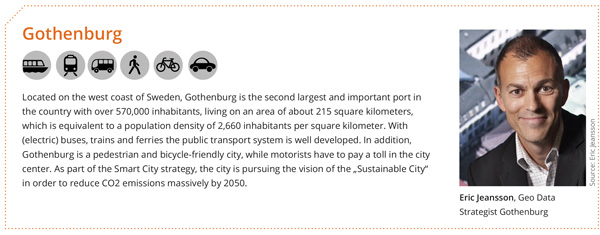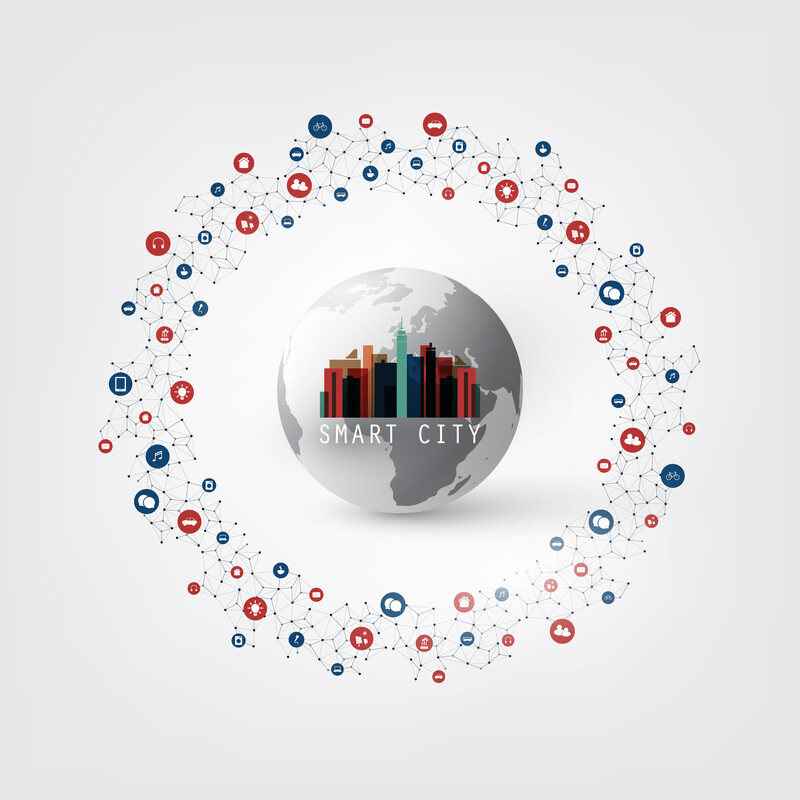Autor: Andreas Eicher
There is one thing that pioneers of smart city visions have in common: finding new ways of a future-oriented cohabitation on increasingly narrowing space because in 2050 “two-thirds of the then nine billion people worldwide will live in urban conurbations“ [1]. But how can the coming path look like? The editorial team at gis.Business has been searching for answers in three different cities. We met Harvey Phalatse from Johannesburg in South Africa, Eric Jeansson from Gothenburg in Sweden and Werner Spec from Ludwigsburg in Germany for an interview. From what they have to tell us we will learn what intelligent thinkers and drivers of these different places have in mind.

What are the main features of your smart city strategy and with such a strategy which milestones and targets are you aiming at?
Harvey Phalatse: The City of Johannesburg Metropolitan Municipality has embarked on a journey to transform Johannesburg to become a smart city in terms of economy, environment, utilities, transportation, education, health, planning, governance and people. The smart city agenda is intended to support the city’s long-term Growth and Development Strategy Paradigm. In summary this means: “Do more with less” and thus being more efficient across the whole city saves enormous costs. “Do it better” and thus being more effective increasing the quality of the services, as well as “Do new things” and thus being innovative, utilising new opportunities and experimenting with new concepts.
Our Smart City Strategy and implementation Roadmap was approved in July 2014, as a guiding document towards a holistic smart city approach which is cross domain and multidisciplinary, citizen and people oriented (active engagement), leveraging local infrastructure, connectivity, resources and providing a common underlying smart platform that is interoperable.
Eric Jeansson: The sole purpose of being a “mart city“ for Gothenburg is to be able to provide better public services and increase attractiveness to our main stakeholders – citizens, visitors and the business sector. Some of the main features of the concept are the city´s ability to be a dynamic and agile organisation; we want to be open for change and using learnings in a structured way, delivering the sustainable city. A smart city consists of a number of interconnected systems with the ability to manage complex, and sometimes wicked, challenges and opportunities. The smart city is connected, use open data and services-/information platforms, while capitalizing on digitalization and new technology to improve life for citizens, visitors and the business sector.
Werner Spec: For the city of Ludwigsburg the smart city concept is not an end in itself. We take advantage of the many opportunities of digitization in order to achieve the objectives of a sustainable urban development in the fields of economy, society and ecology and to issue intergenerational equity more effectively.
It is therefore a matter of our concern to actively participate in the digitization for the benefit of the people in order to counteract a dominance of purely economic motivation and to ensure the interests of data security and openness of the systems for all. To coordinate the digitization strategy we established the Innovation Network Living LaB Ludwigsburg, where we work together in a unique way with partners from industry and research institutions.
Our smart city strategy is based on the eleven subject areas of the urban development concept, which has been worked out with the people of the city: our work program for the future. The main objectives are to ensure intergenerational equity and quality of life at a high level. In this way we focus on various areas of advanced urban life: varied housing opportunities for all population groups, attractive business locations, the strengthening of the city as a location for shopping, the provision of high-quality green and open spaces, environmentally and socially sustainable mobility and a secure and affordable energy supply by increasing energy conservation and more renewable energy.
Many cities are committed to the Smart City theme. What does it need in your view to have the subject not only on paper but to master it in a practical way as an overall concept in order to meet future challenges?
Harvey Phalatse: In implementing our smart city strategy as the City of Johannesburg, we have identified the following key lessons which we have taken in to account as we take this important programme forward. Strategy and leadership buy in is very important and for us the programme is sponsored at the level of the Executive Mayor and the Municipal Manager. And, we have aligned our smart city strategy outcomes with the long term Joburg Growth & Development Strategy 2040 as well as our 5 year mayoral term Integrated Development Plans. It is important for us to put in place governance structures with clear roles and responsibilities. Further we need to put in place good processes and have well balanced portfolio of programmes/projects. Sustainability and on-going communication with key stakeholders is very important in this overall process.
Eric Jeansson: The approach we are taking is to focus on the fundamental effects of the various tasks at hand, such as city planning and development, welfare services, attractiveness – smart city is a good way to describe an approach that leads to improved effects. Since we are so focused on the city´s overall objectives/effects, smart city as a theme becomes a necessity in various perspectives, hence - we miss our overall objectives unless we deliver on priorities in the smart city context.
Werner Spec: A well-established dialogue among the administration, citizens, politics, businesses and research institutions ultimately determines the quality of the urban development process and thus whether the objectives of the Smart City strategy can be achieved. A management cycle provides the basis for the process of sustainable urban development here, ensuring a dynamic elaboration of the urban development concept. We believe that the indicators based on success, as well as the change and the elaboration of the administrative structure is essential.
As a municipality we see ourselves in a special responsibility. It is our responsibility to promote the change, grasp new challenges and bring together stakeholders. The exchange with other municipalities and cooperation with strong partners on site is indispensable in this regard. Our urban development concept that is reflecting a jointly worked out picture of the future shows us the way we are heading and motivates everyone involved. Furthermore, the following factors are helpful in making the process successful: a clear process structure, a city council fostering the changes, the provision of the necessary resources and a high degree of transparency in the administrative handling.

In your opinion, what opportunities does a well-thought-out smart city strategy create for your city?
Harvey Phalatse: We see the impact on economic development and the creation of jobs, the promoting of resource efficiency and the mitigating of climate change and, of course the creation of a greater place to live and work. Beyond that a well-thought-out smart city strategy means focusing on supporting communities, learning initiatives and the usage of digital technologies for better connectivity, user experiences, and improved service delivery.
Eric Jeansson: For us this means better public services and increase attractiveness to our main stakeholders – citizens, visitors and the business sector. By working on that complex task in a “smart” way, we also deliver value more cost-effectively and generate interest, as well as direct investments, from the business community, academia as well as national and international authorities.
Werner Spec: We see a thoughtful Smart City strategy as a condition on the road to a sustainable city of the future, and for ensuring intergenerational equity. A strategy that combines the various solutions and approaches in the city, backed by clearly defined objectives means a comprehensive solution for the city of Ludwigsburg and thus an achievement of the highest added value for its citizens. The close cooperation with industry and research in Living LaB Ludwigsburg allows us to benefit from the research findings and the latest technologies, and to make sustainable products and services accessible to our citizens. This is how we manage the change and develop answers to key questions of the future.
Geoinformation represents an important link in this context. Can you briefly outline from your own experience how you integrate geoinformation meaningfully in the smart city process?
Harvey Phalatse: For the City of Johannesburg we have commenced with the GIS integration processes and looking specifically at mining useful and interesting knowledge from raw data (real-time crowd-sourcing information collected by a wide variety of sensors) for service delivery monitoring purposes. Geospatial data sharing is also being executed in a network mode which assimilates more and more citizens as nodes.
Eric Jeansson: Geo data, or Geo information is an important factor in a smart city concept. In our view it's the key engine driving the smart city. The underlying data model is considered the base for creating intelligent analysis on which we can make smart decisions. In our upcoming new Geo Data Strategy we will put a lot of effort in describing how we can develop such a model for the city. It's also critical to make data, and certainly geo data, open and available within the city, and of course out to the community, as open data.
As an example we have published the entire city as a 3D-model in Minecraft, and further, more detailed 3D data of the city will soon be released. A smart city is an inclusive city. Since 2012 we have worked with a platform called MinStad/My City (minstad.goteborg.se), which is a world unique arena for citizen dialogue and public participation. Over 1200 public suggestions about city development have been recorded since the start, and in September last year a new mobile app was released. All comments are used as inspiration in the planning process and in our mission to build a smart, sustainable and secure city.
Werner Spec: Analysis of data and information is the ground on which decisions are made in order to ensure a resource-efficient and sustainable urban development. Most issues and problems cities are encountering have at least one geographic component. Moreover, approximately 80% of all information has a geographic reference.
Among other things, we have a 3D building model in Level of Detail 2 (LOD2) in CityGML and a green space and tree register. Especially in relation to the energy topic, the building geometry will be of particular interest for the prognosis of the warming heat demand and the generation of electricity by photovoltaic plants.
We are currently planning a Smart City Cloud, in which a large number of urban data are to be imported and linked. Already today, many geo-information (e.g. “mobility and transport”, “environment and nature”, “information and tourism”) are publicly accessible on the of the city of Ludwigsburg’s Internet pages. The new platform makes these data accessible to third parties and combinable with other data sources (e.g. visualization of free parking spaces in urban areas by sensors). As a result, there is the possibility for external users to use the data and to generate added value through new business models and products.

Source
[1] Oxenfarth, Anke: Editorial. In: Oekom Verlag, Gesellschaft für ökologische Kommunikation GmbH (Hrsg.): StadtLust. Die Quellen urbaner Lebensqualität. München, 2015, S. 7.
